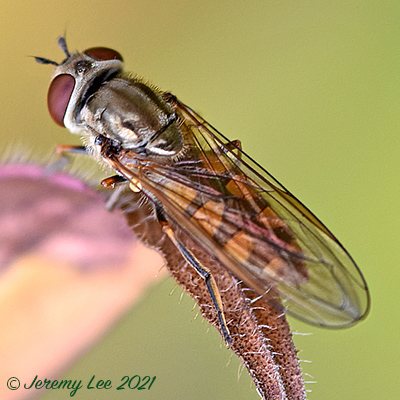
 |
|
Scientific Classifications explained » Amphibians » Ants » Aphids » Bees » Beetles » Birds » Bugs » Butterflies » Caterpillars » Damselflies » Dragonflies » Earwigs » Flies » Frog/Leafhoppers » Fungi » Galls » Grasshoppers » Harvestmen » Hoverflies » Lacewings » Ladybirds » Leaf Mines » Lichens » Mammals » Millipedes » Mosses » Moths » Sawflies » Slugs » Snails » Spiders » Trees & Shrubs » Wasps » Wild Flowers » Woodlice » Postboxes |
UK Nature > Hoverflies > Platycheirus manicatus

Scientific Name: Platycheirus manicatus Common Name: N/A Platycheirus manicatus is one of a pair of yellow-spotted Platycheirus species with a strongly protruding mouth, the front legs of the male with only tarsal segments 1 and 2 enlargened, and the fore tibiae unmodified. Compared with the other Platycheirus species (P. tarsalis), the thorax is duller and paler, the abdominal spots are yellower and the spots on tergite 2 are less separated from the hind margin of the segment. The female frons is very heavily dusted throughout, even on the vertex. Both sexes are more broadly built than P. tarsalis. This is a widespread and common species found in a variety of habitats but perhaps especially drier grasslands. It flies from spring to early autumn but peaks in summer. The relatively long mouthparts allow it to feed on tubular flowers such as Ground-ivy and Bluebell. The larvae are aphidophagous on low herbage and shrubs, but little seems to be known of their precise requirements. |
|

https://www.uknature.co.uk is a website dedicated to showing the immense diversity of UK nature and wildlife. Our vast range of habitats, from lowland arable to snow covered mountains, from storm-ravaged coastlines to peaceful inland freshwater lakes and rivers, from dry, sandy heaths to deciduous and coniferous forests, all these habitats contribute to the abundance of UK nature. We have wild birds in huge numbers either residing or visiting our shores (597 recorded species as at July 2013) and we must also not forget the humble back garden with its grass lawns, flower beds filled with nectar rich flowers, shrubs and trees, all designed to attract huge numbers of insects such as bees, moths, butterflies and hoverflies; and finally the small ponds which provide safe havens for frogs, toads, newts and even slow worms and grass snakes. www.uknature.co.uk is the showcase for my personal passion, photographing uknature in all its glory. I sincerely hope you all enjoy the fruits of my labours. This site and all images contained therein is © Jeremy Lee 2004 - 2025. All Rights Reserved. Site design by Jeremy Lee. Site development & IT Support by Stuart Lee. |